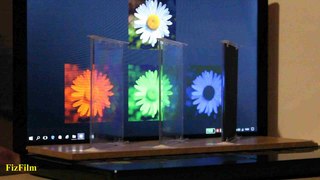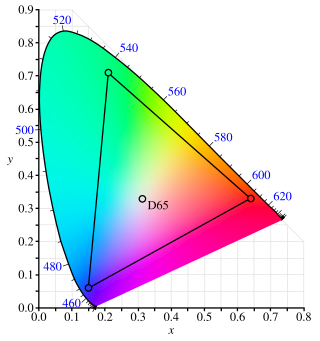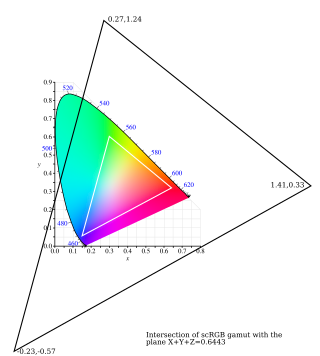
The RGB color model is an additive color model in which the red, green and blue primary colors of light are added together in various ways to reproduce a broad array of colors. The name of the model comes from the initials of the three additive primary colors, red, green, and blue.

An RGB color space is one of many specific additive colorimetric color spaces based on the RGB color model.
Color management is the process of ensuring consistent and accurate colors across various devices, such as monitors, printers, and cameras. It involves the use of color profiles, which are standardized descriptions of how colors should be displayed or reproduced.
Web colors are colors used in displaying web pages on the World Wide Web; they can be described by way of three methods: a color may be specified as an RGB triplet, in hexadecimal format or according to its common English name in some cases. A color tool or other graphics software is often used to generate color values. In some uses, hexadecimal color codes are specified with notation using a leading number sign (#). A color is specified according to the intensity of its red, green and blue components, each represented by eight bits. Thus, there are 24 bits used to specify a web color within the sRGB gamut, and 16,777,216 colors that may be so specified.
Color depth or colour depth, also known as bit depth, is either the number of bits used to indicate the color of a single pixel, or the number of bits used for each color component of a single pixel. When referring to a pixel, the concept can be defined as bits per pixel (bpp). When referring to a color component, the concept can be defined as bits per component, bits per channel, bits per color, and also bits per pixel component, bits per color channel or bits per sample (bps). Modern standards tend to use bits per component, but historical lower-depth systems used bits per pixel more often.

The CIELAB color space, also referred to as L*a*b*, is a color space defined by the International Commission on Illumination in 1976. It expresses color as three values: L* for perceptual lightness and a* and b* for the four unique colors of human vision: red, green, blue and yellow. CIELAB was intended as a perceptually uniform space, where a given numerical change corresponds to a similar perceived change in color. While the LAB space is not truly perceptually uniform, it nevertheless is useful in industry for detecting small differences in color.

In color reproduction, including computer graphics and photography, the gamut, or color gamut, is a certain complete subset of colors. The most common usage refers to the subset of colors that can be accurately represented in a given circumstance, such as within a given color space or by a certain output device.

In digital photography, computer-generated imagery, and colorimetry, a grayscale image is one in which the value of each pixel is a single sample representing only an amount of light; that is, it carries only intensity information. Grayscale images, a kind of black-and-white or gray monochrome, are composed exclusively of shades of gray. The contrast ranges from black at the weakest intensity to white at the strongest.

sRGB is a standard RGB color space that HP and Microsoft created cooperatively in 1996 to use on monitors, printers, and the World Wide Web. It was subsequently standardized by the International Electrotechnical Commission (IEC) as IEC 61966-2-1:1999. sRGB is the current defined standard colorspace for the web, and it is usually the assumed colorspace for images that are neither tagged for a colorspace nor have an embedded color profile.

The Adobe RGB (1998) color space or opRGB is a color space developed by Adobe Inc. in 1998. It was designed to encompass most of the colors achievable on CMYK color printers, but by using RGB primary colors on a device such as a computer display. The Adobe RGB (1998) color space encompasses roughly 50% of the visible colors specified by the CIELAB color space – improving upon the gamut of the sRGB color space, primarily in cyan-green hues. It was subsequently standardized by the IEC as IEC 61966-2-5:1999 with a name opRGB and is used in HDMI.

The ProPhoto RGB color space, also known as ROMM RGB, is an output referred RGB color space developed by Kodak. It offers an especially large gamut designed for use with photographic output in mind. The ProPhoto RGB color space encompasses over 90% of possible surface colors in the CIE L*a*b* color space, and 100% of likely occurring real-world surface colors documented by Michael Pointer in 1980, making ProPhoto even larger than the Wide-gamut RGB color space. The ProPhoto RGB primaries were also chosen in order to minimize hue rotations associated with non-linear tone scale operations. One of the downsides to this color space is that approximately 13% of the representable colors are imaginary colors that do not exist and are not visible colors.
xvYCC or extended-gamut YCbCr is a color space that can be used in the video electronics of television sets to support a gamut 1.8 times as large as that of the sRGB color space. xvYCC was proposed by Sony, specified by the IEC in October 2005 and published in January 2006 as IEC 61966-2-4. xvYCC extends the ITU-R BT.709 tone curve by defining over-ranged values. xvYCC-encoded video retains the same color primaries and white point as BT.709, and uses either a BT.601 or BT.709 RGB-to-YCC conversion matrix and encoding. This allows it to travel through existing digital limited range YCC data paths, and any colors within the normal gamut will be compatible. It works by allowing negative RGB inputs and expanding the output chroma. These are used to encode more saturated colors by using a greater part of the RGB values that can be encoded in the YCbCr signal compared with those used in Broadcast Safe Level. The extra-gamut colors can then be displayed by a device whose underlying technology is not limited by the standard primaries.

scRGB is a wide color gamut RGB color space created by Microsoft and HP that uses the same color primaries and white/black points as the sRGB color space but allows coordinates below zero and greater than one. The full range is −0.5 through just less than +7.5.

Rec. 709, also known as Rec.709, BT.709, and ITU 709, is a standard developed by ITU-R for image encoding and signal characteristics of high-definition television.

A color space is a specific organization of colors. In combination with color profiling supported by various physical devices, it supports reproducible representations of color – whether such representation entails an analog or a digital representation. A color space may be arbitrary, i.e. with physically realized colors assigned to a set of physical color swatches with corresponding assigned color names, or structured with mathematical rigor. A "color space" is a useful conceptual tool for understanding the color capabilities of a particular device or digital file. When trying to reproduce color on another device, color spaces can show whether shadow/highlight detail and color saturation can be retained, and by how much either will be compromised.

ITU-R Recommendation BT.2020, more commonly known by the abbreviations Rec. 2020 or BT.2020, defines various aspects of ultra-high-definition television (UHDTV) with standard dynamic range (SDR) and wide color gamut (WCG), including picture resolutions, frame rates with progressive scan, bit depths, color primaries, RGB and luma-chroma color representations, chroma subsamplings, and an opto-electronic transfer function. The first version of Rec. 2020 was posted on the International Telecommunication Union (ITU) website on August 23, 2012, and two further editions have been published since then.
The Academy Color Encoding System (ACES) is a color image encoding system created under the auspices of the Academy of Motion Picture Arts and Sciences. ACES is characterised by a color accurate workflow, with "seamless interchange of high quality motion picture images regardless of source".

DCI-P3 is an RGB color space first defined in 2005 as part of the Digital Cinema Initiative, to be used for digital theatrical motion picture distribution (DCDM). Display P3 is a variant developed by Apple Inc. for wide-gamut displays.
ITU-R Recommendation BT.2100, more commonly known by the abbreviations Rec. 2100 or BT.2100, introduced high-dynamic-range television (HDR-TV) by recommending the use of the perceptual quantizer or hybrid log–gamma (HLG) transfer functions instead of the traditional "gamma" previously used for SDR-TV.












